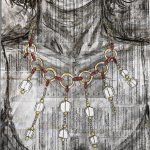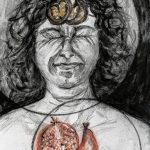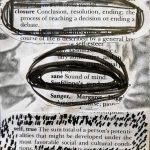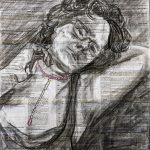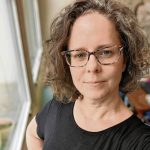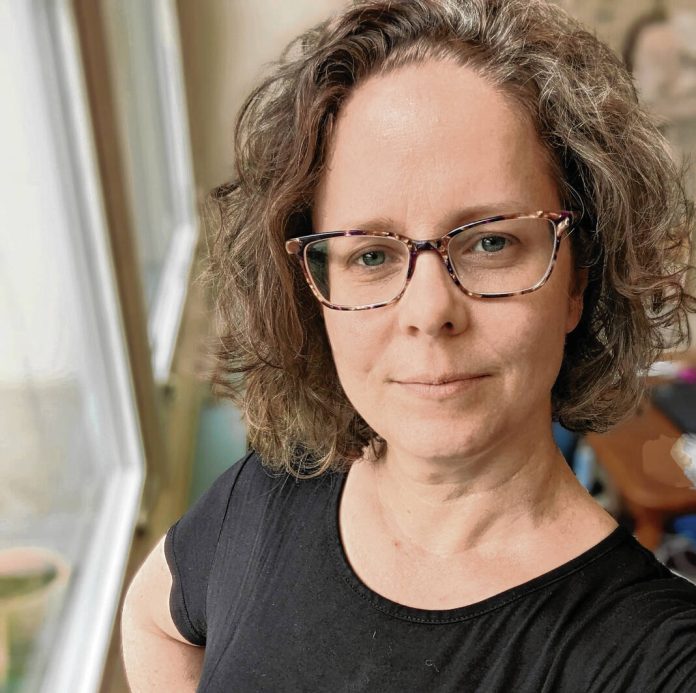
Columbus artist Kimberly Rose Free’s work will be featured in the upcoming 411 Gallery exhibit “Psyche Relics”.
Photo provided
Kimberly Rose Free’s drawings, paintings and mixed media creations that focus on her personal mental health are unflinching and candid. So is the artist in discussing her work.
“There’s a loophole for artists in society. Our madness is more tolerated,” the Columbus native said in an email talking about her upcoming exhibit of works drawing from 30 years of lived experience with depression, anxiety, chronic pain and mental health treatments.
“I decided my path was to come out and just talk about it,” Free said.
Her art will be exhibited at 411 Gallery in Columbus during May in “Psyche Relics,” presented in observance of Mental Health Month by the Columbus Arts Council and Mental Health Matters Bartholomew County Initiative.
“I know it’s a risk to talk about a touchy subject. But maybe the worst happened to me, and I found a way through. I think that’s a valuable thing to share despite the risk.”
Organizers describe the exhibit as a collection of “artifacts from psychiatric treatment over 30 years. … Conceptual and symbolic drawings seek to illustrate her healing from dark distress toward serenity. Aspects of treatment such as journaling, individual and group therapy, electroconvulsive therapy, and medication trials are explored with gratitude and good humor.”
Mental Health Matters Bartholomew Co. Initiative project manager Vachel Hudson said artwork such at Free’s can help people overcome their own biases and misconceptions about mental health.
Art, Hudson said, “humanizes the often misunderstood experiences of psychiatric care, reducing stigma and fostering empathy. In our community, where discussions about mental health are sometimes stigmatized or overlooked, ‘Psyche Relics’ offers a powerful platform for education and awareness.”
The exhibit also will be timely, opening right after Mental Health Matters hosts its “Better Together” Community Update event on April 30 at The Commons, focusing on the current state of local mental health systems, initiatives and plans for the coming year.
Free graduated from Columbus East High School in 1995 and went on to earn a bachelor’s degree in visual art and education from Indiana Wesleyan University, graduating with honors.
After working elsewhere mostly at nonprofits, she said she “got very sick with major depression, panic disorder, chronic pain conditions, and chronic fatigue symptoms.”
Free said she is thankful to “the physical therapists, doctors, clinicians, pharmacists, support groups, community program workers, neighbors, family and friends who helped me through the worst of it.”
Painting, drawing and creating are also therapeutic. “I think for me, it helps to create my own symbolism using anything and everything at hand, to understand my inner self,” Free said.
An expression of this symbolism can be found beyond the clenched and grimacing expression on her face in a charcoal-on-gesso board self-portrait, “Opening.” Drawing from art history, Free depicts her heart as a sliced-open pomegranate and her mind as a cracked walnut. Of this work, she says, “It’s painful to open up in the face of new ideas.”
Free uses found items and unconventional materials, including for example, pharmaceutical instruction paper. In one piece, she depicts herself wearing a luxurious necklace, but rather than gems, the necklace is adorned by differently shaped pills from her own history of prescribed psychiatric medications.
Free says she chooses to live tiny in a space of about 280 square feet, which is supplemented by her studio space as artist-in-residence at her church, St. Paul’s Episcopal, “which is a dream come true.” She also volunteers with Columbus Animal Care Services and with organizations helping people in recovery.
“For Psyche Relics, I hoped to document my lived experience of treatment for future patients and scientists as they continue to explore the human psyche and how to help it. I was lucky to be born at a time with medication and therapies, but in the future I believe psyche treatment will disconnect from profit motives,” she said.
“Society will be more tolerant of differences, respectful of pain, and offer people the time and support it really takes to stabilize and heal mentally.”
Organizers describe the work in “Psyche Relics” as vulnerable but also playful. But there is also beauty in the work, which Free also sees in her life.
“The current beauty of my life was born out of the so-called problems,” she said. “The art is beautiful because it is vulnerable. The content is beautiful because it came out of a vulnerable person. The community is beautiful because we, in our vulnerability alone, build it for each other as a group, where there is more strength than any one person needs.
“Vulnerability is not a thing to fear, it is a thing to honor and hold as precious.”
Drawings by Kimberly Rose Free sometimes use intriguing media and imagery. This self-portrait done in charcoal on prescription instruction paper also features a necklace made of psychiatric prescription medications.
Photo provided
Kimberly Rose Free’s self-portrait “Opening” draws on art history to depict her heart as a sliced-open pomegranate and her mind as an open walnut. “They are opening to all the emotions and knowledge of life and living. I was choosing to open up and see what happened,” she says.
Photo provided
Organizers describe exhibits in Kimberly Rose Free’s upcoming “Psyche Relics” at 411 Gallery in Columbus as both vulnerable and playful.
Photo provided
Drawings by Kimberly Rose Free sometimes use intriguing media and imagery. This self-portrait done in charcoal on prescription instruction paper also features a necklace made of psychiatric prescription medications.
Photo provided
Organizers describe exhibits in Kimberly Rose Free’s upcoming “Psyche Relics” at 411 Gallery in Columbus as both vulnerable and playful.
Photo provided
Columbus artist Kimberly Rose Free’s work will be featured in the upcoming 411 Gallery exhibit “Psyche Relics”.
Photo provided

